We’re kidding ourselves if we think healthcare consumers aren’t in control. That their unprecedented level of choice and digital agency isn’t driving the evolution of the healthcare marketing funnel. Need a dentist? Pick up your smartphone, run a local Google search, and have a practice on the horn within minutes.
Table of Contents
Considering rhinoplasty? You can probably find a patient testimonial video that will give you an idea of what the process looks like. Does it hurt? How long is the recovery period? What about insurance? Who knows—maybe that’s all the information you need to book an initial consultation.
The point is, things are less linear these days for healthcare consumers. Some start at the beginning of the funnel and follow a linear path. Others slide in edgewise and turn the whole thing on its head. This presents some new considerations for healthcare marketers.
It’s no longer enough to rely on simply capturing demand at the bottom of the funnel—you need to be present at all stages and enrich their experience.
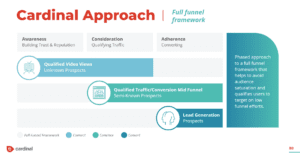
How the Healthcare Marketing Funnel is Evolving
In the context of stringent HIPAA regulations, a full-funnel marketing strategy becomes vital for healthcare marketers. These regulations limit the use of tools like Meta or Google Pixels for creating advertising audiences, necessitating alternative approaches. A full-funnel marketing strategy allows you to maximize conversion potential while still maintaining HIPAA compliance. You can guide patients through their entire healthcare journey,
What else is different today? The need to account for a proliferation of variables—far more variables than the traditional marketing funnel. For one thing, the funnel is flattening, meaning it doesn’t always resemble the upright funnel graphics that often depict it.
Often, the four stages we’ve outlined above will blur. Occur out of order. Simultaneously. At the very least, most healthcare marketing funnels are more non-linear these days, with people moving back and forth through phases as they near their healthcare decisions.
There are also the people in the consumer’s decision-making unit to consider, too. A decision-making unit includes brothers, sisters, sons, daughters, husbands, wives—anyone who influences the decision. You’ll find decision-making units involved with complex decisions like senior care, surgical treatments, etc. And like the healthcare consumers they support or advocate for, members of the decision-making unit have their own informational needs across the funnel.
The Case for a Full-Funnel Marketing Strategy
Relationships are important. Healthcare consumers tend to stick around, follow up, and come back when their providers continue to elevate their experiences. In business-speak, we might call this value creation. In human-speak, we’re talking about cultivating loyalty.
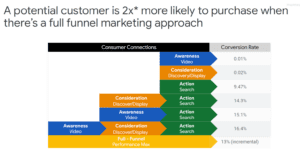
By strategically reaching patients at various stages, you can establish a consistent narrative and reinforce key messaging throughout the patient journey. Positive perceptions, associations, or experiences at any stage of the funnel can influence and enhance the overall brand perception and trust across all channels, not just paid media.
Here’s Jacob Ader, Julien Boudet, Marc Brodherson, and Kelsey Robinson on this very topic, writing for McKinsey:
“Many CMOs shift too much of their marketing spend toward the easy-to-justify capture of customers at the bottom of the funnel at the expense of the less tangible generation of customer demand and attention at the top. This skew toward bottom-of-the-funnel campaigns has significant implications for long-term value: data from three large marketers in media and apparel retail industries indicate that customers who have an emotional connection to a brand tend to be more loyal and valuable over time than those who arrive at a site because of a generic keyword search or social media ad.”
What does that “less tangible generation of customer demand and attention at the top” look like? Many different things. An ad I recently encountered for Invisalign comes to mind. The company offers a convenient approach to getting affordable teeth straighteners. Where did I encounter that ad? While listening to a podcast.
The point is, it was more human, memorable, and relatable than, say, a PPC ad. And that made a brand impression on me, the listener. Of course, there’s one more step to this approach: consistency and reinforcement. Achieving brand consistency across channels is no small feat (nor is measuring brand performance). However, the more consistent you can be, the more unified the experience will be, no matter the consumer’s entry point into the funnel.
Using strategies like sequential messaging can help effortlessly guide your audience through every stage of the funnel. Showcasing a series of tailored videos that evolve from raising brand awareness to driving decision-making can ensure each message resonates with the audience’s current stage in their healthcare journey.
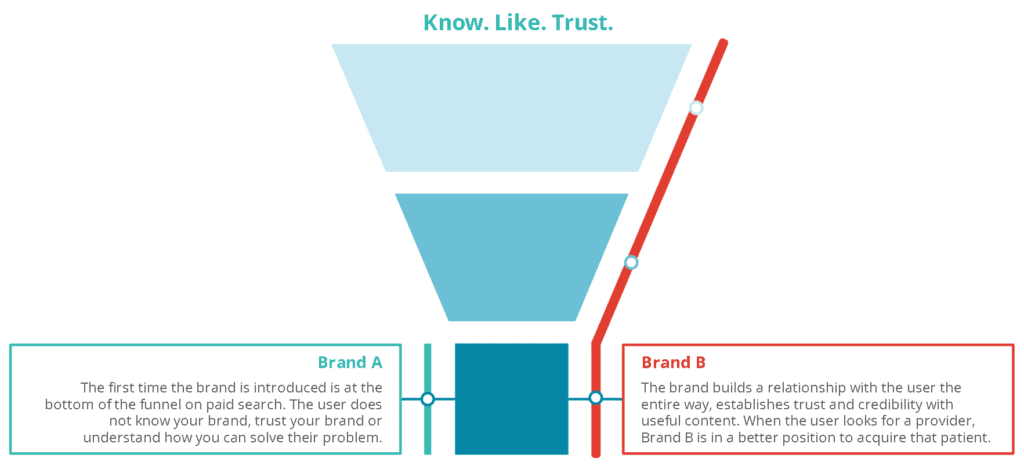
Tailored strategies like this are crucial, especially as consolidation increases in the healthcare industry and markets become more competitive. It’s not enough to simply focus on the high-intent consumers at the bottom of the funnel. You need to build your brand and create consumer demand—and that requires a full-funnel marketing strategy.
Overview of the Healthcare Marketing Funnel Stages
At a high level, the healthcare marketing funnel stages breakdown as follows:
1. Top: Awareness
At the top of the funnel, healthcare consumers are typically dipping their toes in the water. They have a healthcare issue but may not know exactly what is wrong or how to treat it. They’re looking for information to better understand their symptoms and what to do next.
Here is an opportunity to show consumers that you know a thing or two about their problem. You can use blog posts, checklists, infographics, and other content to educate people and help them. This is a great way to reach people on search engines when they’re asking Google questions like “Why does my tooth throb when I eat ice cream?” or “Is it normal to feel dizzy after exercise?”
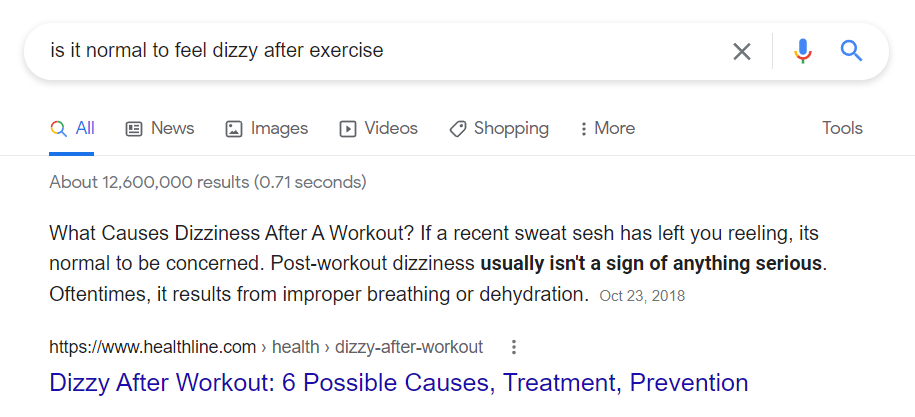
You might also consider social media campaigns as a way to educate prospective patients on common issues that they may not even be aware of. Instead of waiting for them to search, you’re highlighting medical issues they’ve yet to articulate on the channels they spend the most time on.
2. Top-Middle: Consideration
At this stage, people are looking for solutions. They have a better idea of their medical issue and are now trying to fix it. They’re looking for educational content, customer testimonials, and other material that helps them understand their choices better. This stage is a great opportunity to educate, nurture, and engage consumers, typically with:
- Robust solutions and treatment pages
- Case studies and patient testimonials
- Email marketing sequences that keep them engaged as they evaluate treatment options
3. Bottom-Middle: Decision
At this point, patients are ready to receive care. They’re evaluating providers, and whoever can demonstrate their credibility and offer a great patient experience will likely win. Don’t forget they’re also considering simple things like:
- Insurance accepted
- Location
- Hours and availability
You want to make it as easy as possible for consumers to convert into appointments, calls, or consultations—whatever a bottom-middle conversion looks like for you. As far as content or campaigns go, this is the time to introduce success stories and special offers to entice someone on the fence.
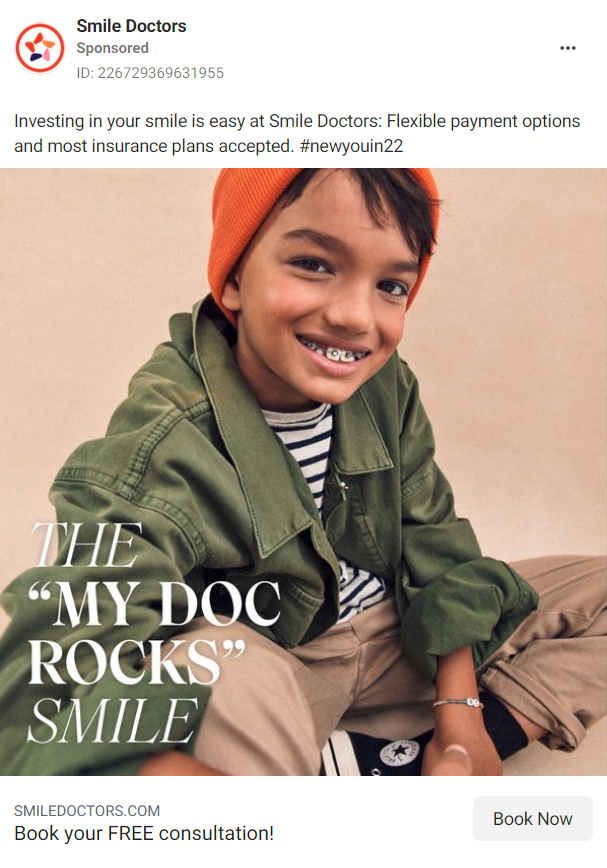
This is also the time to consider conversion rate optimization (CRO) best practices that make it easier for consumers to find and complete your form, call the office, or convert on a landing page.
4. Bottom: Buy Long-Term
Here’s where you convert consumers into long-term patients. It’s where you build loyalty through stellar experiences. Your quality of service, communication, and follow-up will all be highly important at this stage in the funnel. Here are some ways to bring value at the bottom of the funnel:
- Personalizing email nurturing campaigns in which they receive tips, guidelines, and other info that helps them make better health decisions
- Appointment preparation, text and email reminders, and follow-up info
- A patient portal and mobile app for more personalized experiences
- Periodic direct mail reminding consumers how they can get most out of their patronage
How to Reach People with a Diverse Channel Mix
The patient journey is more complex than ever, making an omnichannel strategy essential. You need to consider the entire spectrum of touchpoints that patients encounter while seeking care. This will expand your audience reach and engage with your target audience where they already are spending time online.
To craft a comprehensive omnichannel strategy that goes beyond traditional advertising, integrate organic and earned content. This not only builds your brand’s authority and trust but also reinforces your paid advertising efforts. When patients have previously encountered your brand organically, they’re more likely to engage with your ads.
Consider these organic content strategies for different stages of the patient journey:
- Awareness Stage: Utilize blog posts, checklists, and infographics to educate potential patients and establish a foundational awareness of your brand.
- Consideration Stage: Offer educational content like detailed treatment pages, case studies, and patient testimonials, along with engaging email marketing sequences.
- Decision Stage: Focus on converting prospects into patients. Highlight success stories, patient testimonials, and special offers to facilitate this decision-making process.
- Buy Long Term: Enhance long-term patient relationships through personalized communication, like tailored email campaigns, appointment reminders, and educational content. Additionally, leveraging digital tools like patient portals and mobile apps can significantly improve the patient experience.
If applicable to your organization, take into account digital channels such as programmatic video, native advertising, display ads, over-the-top (OTT) media services, as well as social platforms like Facebook to maximize reach and engagement.
Making the Most of Every Channel in Your Funnel
Speaking of digital channels, a healthcare marketing strategy that drives new patient acquisition uses channels that connect with people during their everyday online habits. Creating real impact means knowing how to build seamless, cross-platform strategies and when to let each channel shine on its own.
According to new data from SparkToro and Datos, a mere 148 keywords now account for 15% of all Google searches.
This shows that organic search traffic is increasingly concentrated among a small number of terms, often dominated by branded or navigational queries like YouTube, Gmail, and Amazon. It’s no longer enough to rely solely on SEO or hope to rank for countless query variations. Building a recognizable brand that patients actively search for and expanding visibility across multiple channels is a must.
Here’s how different channels fit into a full-funnel approach—and why integrating them can make all the difference.
Google: Search, Ads, and PMAX
Google remains a go-to for reaching people actively searching for answers. Ads and search results catch attention when someone types in questions like “What causes neck pain after sleep?” It’s all about being the trusted voice in moments when patients are already seeking solutions.
With Performance Max (PMAX), Google takes this to the next level by letting you create a fully contained funnel within its ecosystem. PMAX uses Search, Display, YouTube, and even Maps to guide people through their healthcare decisions. A patient might first spot your clinic through a search ad, see a YouTube testimonial later, and eventually use Maps to locate your nearest office. The funnel evolves alongside the user, adapting to their behavior in real-time.
Programmatic Ads
Programmatic advertising acts like an invisible guide, placing your ads exactly where your audience already is. If someone looks up injury rehab on a fitness blog, they might later spot your ad on a cooking site they visit next. This channel works across funnel stages—sparking awareness with display ads or helping with decisions through retargeting. It’s less about shouting and more about gently leading people closer to your services.
Social Media
Social platforms like Meta and TikTok turn healthcare marketing into something approachable and even fun. Facebook and Instagram are great for community-driven efforts—like sharing seasonal wellness tips through posts or running short video ads that introduce your services. TikTok, meanwhile, lets you craft bite-sized, engaging clips on topics like hydration or stretching, perfect for grabbing attention from younger audiences.
The Magic of Integrated and Cross-Platform Funnels
The true impact lies in weaving these elements into a cohesive strategy. Picture a full-funnel social media campaign: an initial video ad highlights recurring pain, follow-up ads educate about the underlying issue, and later ads showcase your facility as the solution.
Next, they turn to Google to dive deeper into the condition and treatment options, discovering your blogs and building trust with your brands and providers. When they’re ready to book an appointment, they find your Local Service Ad (LSA) through a Google search for “best doctor near me.” Already trusting you, they call and book an appointment.
Cross-platform efforts make the experience feel connected, ensuring patients choose you in crowded markets. When every channel works as part of a larger strategy, the result is a smooth, intuitive experience that helps people feel supported wherever they start their search.
Why Not Just the Bottom Funnel?
I get this question from marketing partners all the time: “Why not just focus on the bottom of the funnel?” On the surface, it seems like the simplest way to drive conversions—after all, you’re targeting people who are ready to act. But in reality: when you zero in only on BOFU, you’re leaving a huge opportunity untapped. A full-funnel strategy goes beyond capturing available demand; it’s about building meaningful connections at every stage, and growing trust in your brand and building more demand.
Here’s why a full-funnel approach is better:
- Reach People Earlier in Their Search: When you focus only on the BOFU, you’re targeting people already close to making a decision. While that sounds efficient, it skips over those in the earlier stages of their journey who are exploring options or looking for answers. A full-funnel approach helps engage those audiences too, pulling more people into your orbit over time.
- Keep Potential Patients Interested: It’s easy for people to lose interest if they aren’t ready to book or buy immediately. Engaging them earlier—through educational blog posts, testimonials, or eye-catching video ads—means staying top of mind. That way, when they’re ready to act, they’re already familiar with your brand.
- Cut Down the Time It Takes to Decide: Reaching people early and often builds trust. By the time they reach the point of making a decision, they’re more confident in choosing you. This can shorten the time they spend deliberating, moving them through the funnel faster (i.e., faster conversion times) than if they’d only encountered your brand at the end.
- Boost the Quality of Your Conversions: A more comprehensive funnel also means your leads tend to be better informed and more committed by the time they convert. They’ve had more touchpoints and opportunities to learn about your offerings, leading to higher-quality engagements and long-term relationships.
Aiming higher up the funnel isn’t about abandoning BOFU tactics; it’s about adding layers of connection and trust. By meeting patients wherever they are, you’re not just growing your audience but nurturing lasting loyalty that pays off in the long run.
Use a Holistic, Consumer-First Approach
It’s not that the four layers of the marketing funnel are going by the wayside—they’re most certainly not. But the days of top-loading or bottom-loading the healthcare marketing funnel do seem to be numbered. And while marketers can’t account for every variable across this new, non-linear funnel, they can do one thing that will permeate the funnel far and wide: They can get to know their target consumer’s needs, wants, fears, and aspirations.
When marketing campaigns, content, and other activities map back to a firm understanding of the consumer, the rest seems to take care of itself.

